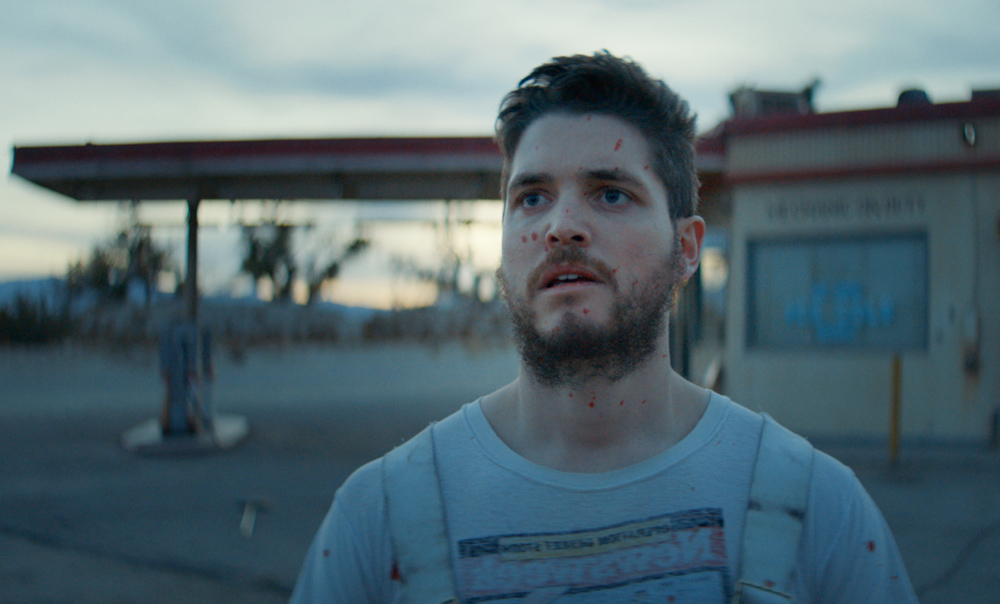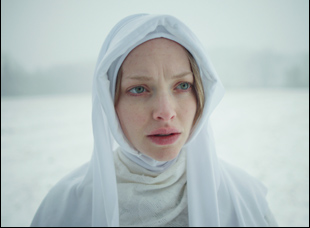When Eli Powers was growing up, friends of his parents would often say with a name like that he ought to be in the movies. Little did they know at the time, he wanted to be the one making them.
“It was always supposed to be this,” Powers says of his path to filmmaking. “And it has to be, otherwise I’m going to live in the woods or something. If I couldn’t do this, I’d have to pull a Christopher McCandless because there’s no middle ground for me.”
Thankfully, a sense of purpose, a considerable amount of talent and, indeed, a great name to put atop a marquee all lined up rather perfectly for Powers, so it shouldn’t be much of a surprise that he became interested in what can be considered a miracle with his short “Holy Moses,” a wry and transcendent short that recently made its way to the Austin Film Festival after making its premiere at Raindance Film Festival in England. Told across two continents, the film finds Amanda Seyfried and Philip Ettinger, who ironically could be seen last as a couple growing distant from their religion in “First Reformed,” on opposite ends of the earth, with Seyfried as a nun at the Magdalene Asylum in Northern Ireland, concerned with a dream she’s had of a sick cow, while Ettinger plays Justice, a seemingly dim-witted gas station attendant in West Texas who can’t believe what he’s seeing when a wayward cow enters his place of business. While Justice is quite taken with this sight, thinking it is perhaps a sign of God — a notion that’s given greater credibility by the bush that suddenly burns outside — the sheriff (Thomas Sadoski) he calls to look into the matter, along with the doctor (Dan Bakkedahl), are far less convinced.
A sense of wonder pervades “Holy Moses,” not just in whether Justice is right to believe that what he’s seen is the work of the divine or merely a case of strange coincidence, but in Powers’ filmmaking where both of its locales have an air of magic and mystery about them, with the quilt of snow laying over the nun’s convent and the Texas desert heat so conducive to mirage lending an enigmatic quality and a sense of escapism bound to sweep you up. Working with an impressive cast, Powers toes the line tonally between absurdity and profundity admirably and while the filmmaker was in Austin, it was our great pleasure to talk to him about creating such a grand production with a limited time frame, the personal inspiration behind the story and adjusting to nature and in some cases, bending nature to the film’s whims.
It has a couple different origins. Purely visually, there’s a weird story about a cow that escaped a truck in Germany and wandered into a convenience store and got shot and just that image of the cow stayed with me. On an emotional, spiritual level, I had this totally bizarre health experience. My thyroid went out of whack and it manifested almost as a manic episode, so I suddenly felt like I understood the world and God was very real. I got very religious all of a sudden and [thought], “Oh man, miracles are all around me and real.” But really, it was like, “Oh no, your thyroid is just out of whack here.”
When the doctors had it all figured out and put me on medicine, in the snap of a finger – I lost all of those deeply spiritual insights and connections to a higher power I had been experiencing – that feeling of rubbing shoulders with the supernatural. So it was losing that contact that inspired Justice’s journey, finding beautiful, weird connections in the universe that may or may not be miracles, and also what makes it a tragic one [since] the beginning of this story, he realizes that miracles are very real and all around him, only to have them taken away again. All of that was floating around in my head when I wrote it, and I didn’t really realize that until much later.
How did you Amanda Seyfriend come on board? It seems like you can connect the entire cast back to her.
She’s like my Hollywood guardian angel. I used to work as her personal assistant and over time we just forged a personal connection and became friends. I actually wrote this script with her husband Thomas Sadoski in mind for the sheriff – and I gave it to him and when he read it, [he told Amanda], “You should really read this.” I didn’t even give it to her, but [Thomas] did and she approached me and she said, “Let’s make this.” And I was like, “Holy shit. Let’s do it.” From there, it started becoming a reality.
What was it like figuring out this logistically? It seemed like it must’ve been two different shoots.
We shot on a cow farm in upstate New York [for the Northern Ireland section] in a blizzard, which wound up so perfect because if it hadn’t been totally snowing, it might not have camouflaged it as much, and we shot L.A. for Texas. I would’ve loved to shoot here [in Texas], but because Dan Bakkedahl and Thomas Sadoski are working on a television show out there, so [it made it easier to] commute, so we did L.A. and New York.
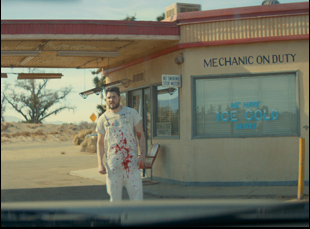
Yeah, that place is so perfect, it’s almost too perfect because I see it now in commercials all the time and I’m like, [shakes head]. It’s very used because it’s so iconic and has that look and oftentimes, as I’m writing it, [I have a certain idea] and then you get on set and you look at the location and you have to compromise something between those things. But here, there was no compromise. That’s what I wrote.
Did one shoot influence how you went about the other?
Yeah, we shot Ireland first and the whole time I wanted them to be separate worlds that had their own very distinct looks. I actually played around with it for a while because I [thought in the narrative], we can either start with Texas and then end with Ireland and you understand in retrospect where the cow came from. We tried intercutting it, but it didn’t really work. Because there’s two different DPs [Jordan Hall and Colt Aidan Shelton] for both those shoots too, which wasn’t originally planned, it worked in the end for the vision we were going for.
Plus, you got the cow farm out of the way. What was that part of the shoot like?
The smell of the cows didn’t leave my clothes for a month. [laughs] Jordan, who shot this thing, and I would go through the dailies for weeks, doing little rough cuts and we’d just be like, “What’s that smell?” It’d be back with us all the time. And the cows weren’t really well behaved. For instance, there was a really brief shot where we’re moving towards the cow standing still in the field, and we actually have a woman in a red coat hugging it so it wouldn’t run away. they weren’t happy to be on camera – that one wasn’t, at least, so a woman is standing there and we had to rotoscope her out. But cows are beautiful creatures and I was happy to have them in there. And now I think there’s something in the collective consciousness because we were just at Raindance and there’s two other short films that have cows in them and we’re like, “What’s going on right now? What are these cows trying to tell us?”
We [also] shot at a Catholic church in upstate New York and the [priest there] was really sweet. In a very charming way, he was trying to convert us when we left. He came out and passed out all of these books about Mother Teresa, so we went home after the shoot with a box of books.
I wonder because Amanda just had a baby and she’s pregnant in the film, was that something you worked into the script?
She was really pregnant when we did it. We shot it before “First Reformed” where she’s also pregnant and that did factor into writing things. That character of Mary at the Magdalene Asylum and that whole world, I was building it as we were going. The original script was mostly just Texas and a cutaway to Ireland at the end, but then when I found out Amanda wanted to be involved, I was like, “By the way, here’s this monologue…”
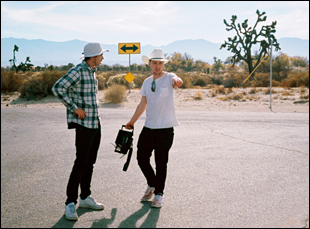
We were so pressed for time. We shot it in three days. One day for Ireland, two days for Texas, and there’s some good lines that Tommy has as the sheriff that, for whatever reason, I didn’t hear [while on set], like little improvs that I thought were really on point for his character early on.
I [also] didn’t always plan on the short being a feature, but just because I’ve been sitting with it so long, I’ve been getting more and more excited about [that prospect]. The character of the priest ends up having this giant, bizarre arc across both time periods and while we were shooting on set, I would go and whisper little things in Philip Ettinger’s – Justice’s ear, like, “Hey, after this, you become a mega-preacher and you rise to power in Texas.” And he’s like, “What?!?” And I’m like, “That’s what happens.” So while we were shooting, [that] started clicking more and more too.
There seems to be some subtle connective tissue between the two haves, such as Justice and the nun both wearing white, and the intermingling of the score. How much of a connection did you want there to be?
That’s all stuff maybe more intuitive than deliberate. Looking at it now, I’m like, “Oh yeah, he is wearing white overalls and she’s wearing white” – and I wrote it in the script early on, but that’s just what happened organically. And as far as the score, I got really lucky. Lydia Parkington is a brilliant cello artist and musician in general, and she really helped meld the two worlds together because we talked a lot about how music could complement each other. The music at the end that’s playing under the credits is cello music with banjo, and [we felt] banjo was the heartbeat of Texas and cello’s the heartbeat of Ireland, so those come together at the end.
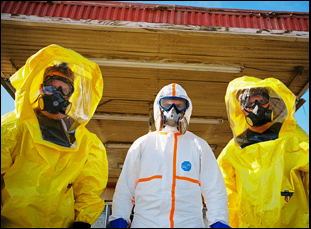
It was tricky because we didn’t want to actually practically do the fire there, mostly because while we were shooting, it was during the time when L.A. was on fire [with all the wildfires], so we didn’t even want to touch that logistically. We did that all in post, which was a new experience for me, crafting the look of the fire and the way it moves. Amanda was really involved in that process. She had a lot to say about fire – I didn’t know she would be such a fire connoisseur, but she is. [laughs]
What’s it like getting to the finish line and bringing it out into the world?
It really feels good to share it with people and I hope it’s just the start of something. Even though it is a finish line for the short, I feel like it’s really the starting line for the feature. The gun’s going off and I want to keep the momentum [going] and keep exploring this world because I don’t even really know everything about it yet, I just want to live in it for longer.
“Holy Moses” will next play at the Savannah Film Festival on November 1st at noon at the Trustees Theater.




